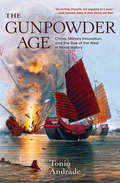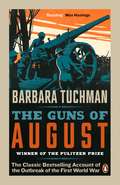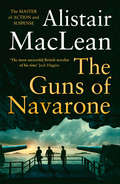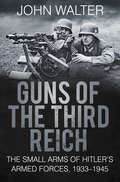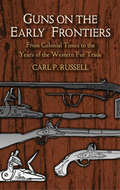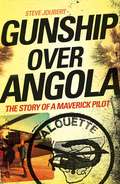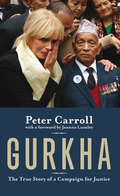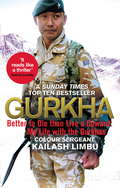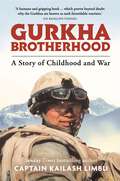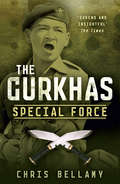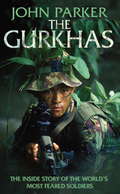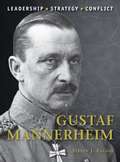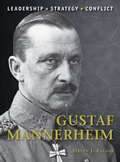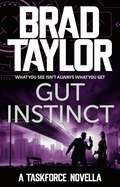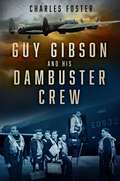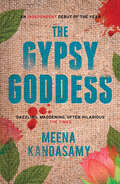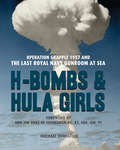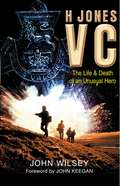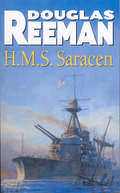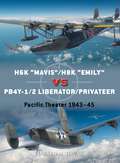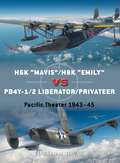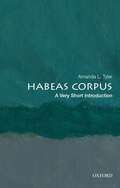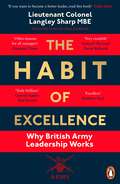- Table View
- List View
The Gunpowder Age: China, Military Innovation, and the Rise of the West in World History
by Tonio AndradeA first look at gunpowder's revolutionary impact on China's role in global historyThe Chinese invented gunpowder and began exploring its military uses as early as the 900s, four centuries before the technology passed to the West. But by the early 1800s, China had fallen so far behind the West in gunpowder warfare that it was easily defeated by Britain in the Opium War of 1839–42. What happened? In The Gunpowder Age, Tonio Andrade offers a compelling new answer, opening a fresh perspective on a key question of world history: why did the countries of western Europe surge to global importance starting in the 1500s while China slipped behind?Historians have long argued that gunpowder weapons helped Europeans establish global hegemony. Yet the inhabitants of what is today China not only invented guns and bombs but also, as Andrade shows, continued to innovate in gunpowder technology through the early 1700s—much longer than previously thought. Why, then, did China become so vulnerable? Andrade argues that one significant reason is that it was out of practice fighting wars, having enjoyed nearly a century of relative peace, since 1760. Indeed, he demonstrates that China—like Europe—was a powerful military innovator, particularly during times of great warfare, such as the violent century starting after the Opium War, when the Chinese once again quickly modernized their forces. Today, China is simply returning to its old position as one of the world's great military powers.By showing that China’s military dynamism was deeper, longer lasting, and more quickly recovered than previously understood, The Gunpowder Age challenges long-standing explanations of the so-called Great Divergence between the West and Asia.
The Gunpowder Age: China, Military Innovation, and the Rise of the West in World History
by Tonio AndradeA first look at gunpowder's revolutionary impact on China's role in global historyThe Chinese invented gunpowder and began exploring its military uses as early as the 900s, four centuries before the technology passed to the West. But by the early 1800s, China had fallen so far behind the West in gunpowder warfare that it was easily defeated by Britain in the Opium War of 1839–42. What happened? In The Gunpowder Age, Tonio Andrade offers a compelling new answer, opening a fresh perspective on a key question of world history: why did the countries of western Europe surge to global importance starting in the 1500s while China slipped behind?Historians have long argued that gunpowder weapons helped Europeans establish global hegemony. Yet the inhabitants of what is today China not only invented guns and bombs but also, as Andrade shows, continued to innovate in gunpowder technology through the early 1700s—much longer than previously thought. Why, then, did China become so vulnerable? Andrade argues that one significant reason is that it was out of practice fighting wars, having enjoyed nearly a century of relative peace, since 1760. Indeed, he demonstrates that China—like Europe—was a powerful military innovator, particularly during times of great warfare, such as the violent century starting after the Opium War, when the Chinese once again quickly modernized their forces. Today, China is simply returning to its old position as one of the world's great military powers.By showing that China’s military dynamism was deeper, longer lasting, and more quickly recovered than previously understood, The Gunpowder Age challenges long-standing explanations of the so-called Great Divergence between the West and Asia.
The Guns of August: The Classic Bestselling Account of the Outbreak of the First World War
by Barbara TuchmanBarbara Tuchman's The Guns of August is a spellbinding history of the fateful first month when Britain went to war.War pressed against every frontier. Suddenly dismayed, governments struggled and twisted to fend it off. It was no use . . .Barbara Tuchman's universally acclaimed, Pulitzer prize-winning account of how the first thirty days of battle determined the course of the First World War is to this day revered as the classic account of the conflict's opening. From the precipitous plunge into war and the brutal and bloody battles of August 1914, Tuchman shows how events were propelled by a horrific logic which swept all sides up in its unstoppable momentum.'Dazzling' Max Hastings'Magnificent' Guardian'Fascinating, splendid, glittering. One of the finest works of history' New York Times'A brilliant achievement' Sunday TelegraphBarbara Tuchman achieved prominence as a historian with The Zimmerman Telegram and international fame with the Pulitzer-Prize winning The Guns of August. She is also the author of The Proud Tower, Stilwell and the American Experience in China (also awarded the Pulitzer Prize), A Distant Mirror and The March of Folly. She died in 1989. The Proud Tower and The Zimmerman Telegram are published by Penguin.
The Guns of Navarone: Force 10 From Navarone (Cinema Classics Ser.)
by Alistair MacLeanThe classic World War II thriller from the acclaimed master of action and suspense. Now issued for the first time as an e-book.
Guns of The Third Reich: The Small Arms of Hitler's Armed Forces, 1933-1945
by John WalterThe armies of the Third Reich were a formidable foe for the Allied forces – largely thanks to the effectiveness of their equipment and weaponry. In this first-class book, renowned firearms expert John Walter examines the full range of guns used from the commercially successful Walter PP and PPK, to the double-action, personal defence pistols Mauser HSc and Sauer M38. Walter also considers the value of weapons that were captured and then used, by the Wehrmacht and the police. Thoroughly researched and illustrated with fascinating examples, this comprehensive reference book covers all significant aspects of design and employment, including data for each weapon on length, weight, barrel, magazine and muzzle velocity. This is an indispensable resource on a compelling subject.
Guns on the Early Frontiers: From Colonial Times to the Years of the Western Fur Trade (Dover Military History, Weapons, Armor Ser.)
by Carl P. RussellThis thoroughly documented, authoritative, and highly readable book not only details the weapons used during the settlement and westward expansion of America but also describes their use by fur traders, trappers, soldiers, and Native Americans. The result is a lively historical examination of the momentous events that were strongly influenced by the gun trade.The text is augmented and enriched throughout with clearly identified illustrations of everything from antique muskets, flintlocks, repeating rifles, and howitzers to bullet molds, powder horns, and other firearm accessories.
Gunship Over Angola: The Story of a Maverick Pilot
by Steve JoubertGrowing up in suburban Pretoria, Steve Joubert dreamed of a career as a pilot. After undergoing SAAF pilot training, a freak injury put an end to his hopes of flying fighter jets. Instead he learned to fly the versatile Alouette helicopter.He had barely qualified as a chopper pilot when he was sent to the Border, where he flew missions over Namibia and southern Angola to supply air cover to troops on the ground. As a gunship pilot, Steve saw some of the worst scenes of war, often arriving first on the scene after a contact or landmine attack.He also recalls the lighter moments of military life, as well as the thrill of flying. A born maverick, his lack of respect for authority often got him into trouble with his superiors.His experiences affected him deeply, and led him eventually to question his role in the war effort. As the Border War escalated, his disillusionment grew. This gripping memoir is a powerful plea for healing and understanding.
Gurkha: The True Story of a Campaign for Justice
by Peter CarrollThe course of a life can be altered by the smallest decisions; the most innocuous events can turn out to have the greatest of consequences. On a Sunday afternoon in 2004, local politician Peter Carroll invited four men into his Folkestone home and promised to help them fight for the right to settle in the country they had served. Five years later, the Gurkhas of Nepal welcomed Peter as a national hero. A losing election battle against the Conservatives in his constituency and a local protest to save village post offices were the only campaigning experience that Peter could bring to the table. But passion, belief and sheer good fortune were on his side. The Gurkha Justice campaign was like a storm. It started slowly, gathering strength over the ensuing months and years before finally building to a crescendo, bursting into the national consciousness and overturning the policy of Her Majesty's Government in spectacular style. For anyone who has lost faith in human nature, Gurkha shows that when good people do good things, the incredible can be achieved. Too many people think that democracy and politics can't deliver, but here is one shining example of our country and its institutions at their very best.
Gurkha: Better to Die than Live a Coward: My Life in the Gurkhas
by Colour-Sergeant Kailash LimbuIn this Sunday Times Top Ten bestselling memoir that 'reads like a thriller', (Joanna Lumley) Colour-Sargent Kailash Limbu shares a riveting account of his life as a Gurkha soldier-marking the first time in its two-hundred-year history that a soldier of the Brigade of Gurkhas has been given permission to tell his story in his own words.In the summer of 2006, Colour-Sargeant Kailash Limbu's platoon was sent to relieve and occupy a police compound in the town of Now Zad in Helmand. He was told to prepare for a forty-eight hour operation. In the end, he and his men were under siege for thirty-one days - one of the longest such sieges in the whole of the Afghan campaign.Kailash Limbu recalls the terrifying and exciting details of those thirty-one days - in which they killed an estimated one hundred Taliban fighters - and intersperses them with the story of his own life as a villager from the Himalayas. He grew up in a place without roads or electricity and didn't see a car until he was fifteen.Kailash's descriptions of Gurkha training and rituals - including how to use the lethal Kukri knife - are eye-opening and fascinating. They combine with the story of his time in Helmand to create a unique account of one man's life as a Gurkha.'I was completely bowled over by Kailash's book and read it with a beating heart and dry mouth. I felt as though I was at his side, hearing the shells and bullets, enjoying the jokes and listening in the scary dead of night. The skill with which he has included his childhood and training is immense, always discovered with ease in the narrative: it actually felt as though I was watching, was IN a film with him. It brought me nearer than I have ever been not only to the mind of the universal soldier but to a hill boy of Nepal and a hugely impressive Gurkha. I raced through it and couldn't put it down: it reads like a thriller. If you want to know anything about the Gurkhas, read this book, and be prepared for a thrilling and dangerous trip' Joanna Lumley
Gurkha Brotherhood: A Story of Childhood and War
by Captain Kailash Limbu‘Sometimes my mind reaches back beyond the fear and the arid landscapes of war, to memories of childhood that fill me with happiness and laughter.’___________‘A humane and gripping book which proves beyond doubt why the Gurkhas are known as such formidable warriors.’ – Sir Ranulph Fiennes___________This is a searingly honest memoir by Kailash Limbu, a serving Gurkha soldier who undertook five tours of active service in Afghanistan. Kailash Limbu was in the front line of the fighting in Helmand Province. On dangerous resupply missions and on offensive patrols that took them to the heart of the ‘killing zone’, he and his men came under frequent attack from Taliban fighters.He talks of other operations in which he has served – and, perhaps most movingly, of the other Gurkha soldiers – the united band of brothers – with whom he serves and on whom he relies every day.On many occasions he has feared he would not live to see the end of the day – and, inevitably, he lost several friends and colleagues from the close-knit Gurkha brotherhood. His means of coping with the trauma of conflict was to travel back in his mind to his childhood in a remote Himalayan village in Nepal. But even amid the simplicity of mountain life, danger and tragedy lurked.In this compelling narrative Capt Limbu celebrates his Gurkha heritage, relates remarkable stories of courage (his own and others’), and confronts demons that have shaped but never broken him. The result is a record of war and peace that is rare in its honesty and humility.
The Gurkhas: Special Force
by Chris BellamyThe Gurkhas have fought on behalf of Britain and India for nearly two hundred years. As brave as they are resilient, resourceful and cunning, they have earned a reputation as devastating fighters, and their unswerving loyalty to the Crown has always inspired affection in the British people. There are also now up to 40,000 Gurkhas in the million-strong army of modern India. But who are the Gurkhas? How much of the myth that surrounds them is true? Award-winning historian Chris Bellamy uncovers the Gurkhas' origins in the Hills of Nepal, the extraordinary circumstances in which the British decided to recruit them and their rapid emergence as elite troops of the East India Company, the British Raj and the British Empire. Their special aptitude meant they were used as the first British 'Special Forces'. Bellamy looks at the wars the Gurkhas have fought this century, from the two world wars through the Falklands to Iraq and Afghanistan and examines their remarkable status now, when each year 11,000 hopefuls apply for just over 170 places in the British Army Gurkhas. Extraordinarily compelling, this book brings the history of the Gurkhas, and the battles they have fought, right up to date, and explores their future.
The Gurkhas: The Inside Story Of The World's Most Feared Soldiers
by John ParkerTheir ferocity is as legendary as their loyalty to the British Monarch and their regimental histories are crammed with acts of incredible bravery and sacrifice. Their reputation as fearsome fighting men remains undisputed and the mere threat of their kukri knives has put the fear of God into opposing forces throughout the world. John Parker's book is a fascinating testimony to the Gurkhas - a fighting force that stands dramatically apart in British military history.
Gustaf Mannerheim (Command)
by Steven J. Zaloga Adam HookCarl Gustaf Emil Mannerheim is a legendary figure, whose life and career were deeply influential in Finnish and European history. He is viewed by many as the father of modern Finland after leading the 'White' faction to victory and independence in the Finnish Civil War of 1918. He then commanded his country's forces in a sequence of bitter clashes in the ice and snow, in the build-up to, and during, World War II: the Winter War in 1939–40, the Continuation War in 1941–44 and the Lapland War in 1944–45. This study provides a fascinating insight into Mannerheim's career, analysing his traits, his biggest victories and his key enemies. Complete with uniform artwork and detailed tactical maps, it is a comprehensive guide to one of the 20th century's most capable military leaders and statesmen.
Gustaf Mannerheim (Command #32)
by Steven J. Zaloga Mr Adam HookCarl Gustaf Emil Mannerheim is a legendary figure, whose life and career were deeply influential in Finnish and European history. He is viewed by many as the father of modern Finland after leading the 'White' faction to victory and independence in the Finnish Civil War of 1918. He then commanded his country's forces in a sequence of bitter clashes in the ice and snow, in the build-up to, and during, World War II: the Winter War in 1939–40, the Continuation War in 1941–44 and the Lapland War in 1944–45. This study provides a fascinating insight into Mannerheim's career, analysing his traits, his biggest victories and his key enemies. Complete with uniform artwork and detailed tactical maps, it is a comprehensive guide to one of the 20th century's most capable military leaders and statesmen.
Gut Instinct: A gripping military thriller from ex-Special Forces Commander Brad Taylor (Taskforce Novella #2)
by Brad TaylorWhat you see isn't always what you get. The Taskforce – a highly clandestine Special Forces unit – is still recovering from its last mission, when more disaster strikes. A routine surveillance mission takes a much more sinister direction. Top operator Pike Logan won't let it go. Logan stakes his reputation, his life and his future on his hunch. If he's wrong, that's it for him. But if he's right, the Taskforce could prevent a threat that no one else saw coming. Innocent lives are on the line in this Taskforce novella from New York Times bestselling author Brad Taylor. Praise for Brad Taylor: 'It's an excellent read, and I greatly enjoyed it' Nelson DeMille. 'Pike ranks right up there with Jason Bourne, Jack Reacher and Jack Bauer' John Lescroart. 'Logan is a tough, appealing hero you're sure to root for' Joseph Finder. 'Fresh plot, great actions, and Taylor clearly knows what he is writing about' Vince Flynn.
Guy Gibson and his Dambuster Crew
by Charles FosterThe Dams Raid is the RAF’s most famous bombing operation of the Second World War, and Guy Gibson, who was in command, its most famous bomber pilot. Of the six men who made up his crew — two Canadians, an Australian and three Englishmen – only one had previously flown with him, but altogether they had amassed more than 180 operations. Drawing on rare and unpublished sources and family archives, this new study, written by the author of the acclaimed 2018 title, The Complete Dambusters, is the first book to fully detail their stories. It explores the previous connections between the seven men who would fly on just one operation together and examines how their relationships developed in the few months they spent in each other’s company.
The Gypsy Goddess: From the author of 'When I Hit You'
by Meena KandasamyThe provocative debut by the Women's Fiction Prize 2018-shortlisted author of When I Hit You. When women take to protest, there is no looking back. Sometimes it is over working conditions, other times, perhaps, a strike for higher wages. And so, in a hungry, back-broken community of villages in Tamil Nadu, a group of rural workers begin to defy their landlords. The landlords, in turn, vow to violently crush them. But these punishments only serve to strengthen the villagers' resistance - after all, when starvation is the only option, what else is there to lose...?
H-Bombs and Hula Girls: Operation Grapple 1957 and the last Royal Navy Gunroom at sea
by Michael JohnstonPublished to coincide with the 60th anniversay of Britain’s first successful thermonuclear bomb testing in the Pacific, H-Bombs and Hula Girls tells the tale of ten young men brought together through National Service in the Royal Navy and taking part in Britain’s top secret tests near Christmas Island. They experience at extremely close quarters what the world is told were three megaton H-bomb explosions, going on to show their country’s flag in Hawaii, then around the South Pacific, and finally round all of South America. Theirs is the only British warship ever to sail directly from Port Stanley to Puerto Belgrano, mooring next to the Argentine flagship General Belgrano. H-Bombs & Hula Girls evokes the Cold War atmosphere of Britain in the 1950s and the race to secure the nation’s place among the thermonuclear powers, but also paints the picture of a heterogeneous group of young men enjoying life-shaping experiences together: learning to be sailors, exploring island paradises, participating in three vast explosions, being their nation’s goodwill ambassadors as they encounter completely different cultures, and here and there experiencing life-threatening moments and even having their hearts broken. This fascinating memoir of the last Royal Navy Gunroom at sea, crafted from journals, letters, and contemporary records, plus the wonders of hindsight, culminates in the surprising realisation that Operation Grapple may not have been quite what it seemed.
H Jones VC: The Life & Death of an Unusual Hero
by John Keegan Sir John Wilsey'A remarkable book - a worthy tribute both to the man John Wilsey calls "an unusual hero" and to the ethos of the British Army in which he lived and died.' John Keegan in his ForewordThis is the biography of the Falklands War hero whose death in the battle for Darwin and Goose Green was one of the turning points in the whole campaign. It is written with the consent of H Jones's widow, Sara, and is published to coincide with the twentieth anniversary of his death at the climax of the Falklands War. It is the story of an emblematic but complex war hero whose family history was unusual, whose army life included exposure to most of the military problems which Britain has encountered since the Second World War (including security in Northern Ireland, where H Jones was responsible for the search for Robert Nairac), and whose dramatic death and subsequent posthumous VC symbolised an extraordinary campaign which was truly the end of an era.
H.M.S Saracen
by Douglas ReemanMalta 1941. To most people HMS Saracen is just an ugly, obsolete ship with an equally ugly recent history: her last commander is due for court-martial after shelling the troops he was sent to protect. But to Captain Richard Chesnaye she brings back memories - memories of the First World War when he and the old monitor went through the Gallipoli campaign together. It seems that captain and ship are both past their best. But as the war enters a new phase Chesnaye senses the possibility of a fresh, significant role - for him and the Saracen.
H6K “Mavis”/H8K “Emily” vs PB4Y-1/2 Liberator/Privateer: Pacific Theater 1943–45 (Duel)
by Edward M. YoungAn illustrated exploration of the dramatic aerial combats between the US Navy's long-range bomber and Japanese flying boats in the Pacific War.Edward Young explores these rarely written about combats, examining the aggressive and strategic tactics deployed by both US Navy and Imperial Japanese Navy Air Force and analyzing the technical improvements installed throughout the war.The PB4Y-1/2 Liberator/Privateer was the US Navy's first four-engined, land-based bomber, adapted and allocated to fight the U-boat menace in the Atlantic and protect the vast reaches of the Pacific Ocean. The long range, speed, armament and bomb load of the PB4Y-1 enabled the US Navy's Pacific squadrons to adopt more aggressive tactics. The PB4Y-1, and its follow-on PB4Y-2, engaged in dangerous bombing missions against Japanese installations, shipping strikes, and air combat. On the other side, with its doctrine of making the first strike against an enemy fleet, the Imperial Japanese Navy recognized the vital importance of maritime reconnaissance, relying on carrier-based reconnaissance aircraft, ship-borne floatplanes and, for long-range maritime patrol, flying boats. The Japanese would continue to develop their aircraft throughout the war, resulting, among others, in the H6K 'Mavis' and the H8K2 'Emily', which despite never achieving a victory, was regarded by the Allied pilots as the most difficult Japanese aircraft to destroy. Enriched with specially commissioned artwork, including armament and cockpit views, battlescenes and technical diagrams, this title analyses technical specifications in detail. By including first-hand accounts, aviation expert Edward Young provides a detailed account of these one-sided yet dramatic and aggressive combats.
H6K “Mavis”/H8K “Emily” vs PB4Y-1/2 Liberator/Privateer: Pacific Theater 1943–45 (Duel)
by Edward M. YoungAn illustrated exploration of the dramatic aerial combats between the US Navy's long-range bomber and Japanese flying boats in the Pacific War.Edward Young explores these rarely written about combats, examining the aggressive and strategic tactics deployed by both US Navy and Imperial Japanese Navy Air Force and analyzing the technical improvements installed throughout the war.The PB4Y-1/2 Liberator/Privateer was the US Navy's first four-engined, land-based bomber, adapted and allocated to fight the U-boat menace in the Atlantic and protect the vast reaches of the Pacific Ocean. The long range, speed, armament and bomb load of the PB4Y-1 enabled the US Navy's Pacific squadrons to adopt more aggressive tactics. The PB4Y-1, and its follow-on PB4Y-2, engaged in dangerous bombing missions against Japanese installations, shipping strikes, and air combat. On the other side, with its doctrine of making the first strike against an enemy fleet, the Imperial Japanese Navy recognized the vital importance of maritime reconnaissance, relying on carrier-based reconnaissance aircraft, ship-borne floatplanes and, for long-range maritime patrol, flying boats. The Japanese would continue to develop their aircraft throughout the war, resulting, among others, in the H6K 'Mavis' and the H8K2 'Emily', which despite never achieving a victory, was regarded by the Allied pilots as the most difficult Japanese aircraft to destroy. Enriched with specially commissioned artwork, including armament and cockpit views, battlescenes and technical diagrams, this title analyses technical specifications in detail. By including first-hand accounts, aviation expert Edward Young provides a detailed account of these one-sided yet dramatic and aggressive combats.
Habeas Corpus: From The Tower Of London To Guantanamo Bay (Very Short Introduction)
by Amanda L. TylerLegal scholar Amanda L. Tyler discusses the history and future of habeas corpus in America and around the world. The concept of habeas corpus--literally, to receive and hold the body--empowers courts to protect the right of prisoners to know the basis on which they are being held by the government and grant prisoners their freedom when they are held unlawfully. It is no wonder that habeas corpus has long been considered essential to freedom. For nearly eight hundred years, the writ of habeas corpus has limited the executive in the Anglo-American legal tradition from imprisoning citizens and subjects with impunity. Writing in the eighteenth century, the widely influential English jurist and commentator William Blackstone declared the writ a "bulwark" of personal liberty. Across the Atlantic, in the leadup to the American Revolution, the Continental Congress declared that the habeas privilege and the right to trial by jury were among the most important rights in a free society. This Very Short Introduction chronicles the storied writ of habeas corpus and how its common law and statutory origins spread from England throughout the British Empire and beyond, witnessing its use today around the world in nations as varied as Canada, Israel, India, and South Korea. Beginning with the English origins of the writ, the book traces its historical development both as a part of the common law and as a parliamentary creation born out of the English Habeas Corpus Act of 1679, a statute that so dramatically limited the executive's power to detain that Blackstone called it no less than a "second Magna Carta." The book then takes the story forward to explore how the writ has functioned in the centuries since, including its controversial suspension by President Abraham Lincoln during the Civil War. It also analyzes the major role habeas corpus has played in such issues as the World War II incarceration of Japanese Americans and the US Supreme Court's recognition during the War on Terror of the concept of a "citizen enemy combatant." Looking ahead the story told in these pages reveals the immense challenges that the habeas privilege faces today and suggests that in confronting them, we would do well to remember how the habeas privilege brought even the king of England to his knees before the law.
Habeas Corpus: A Very Short Introduction (Very Short Introduction)
by Amanda L. TylerLegal scholar Amanda L. Tyler discusses the history and future of habeas corpus in America and around the world. The concept of habeas corpus--literally, to receive and hold the body--empowers courts to protect the right of prisoners to know the basis on which they are being held by the government and grant prisoners their freedom when they are held unlawfully. It is no wonder that habeas corpus has long been considered essential to freedom. For nearly eight hundred years, the writ of habeas corpus has limited the executive in the Anglo-American legal tradition from imprisoning citizens and subjects with impunity. Writing in the eighteenth century, the widely influential English jurist and commentator William Blackstone declared the writ a "bulwark" of personal liberty. Across the Atlantic, in the leadup to the American Revolution, the Continental Congress declared that the habeas privilege and the right to trial by jury were among the most important rights in a free society. This Very Short Introduction chronicles the storied writ of habeas corpus and how its common law and statutory origins spread from England throughout the British Empire and beyond, witnessing its use today around the world in nations as varied as Canada, Israel, India, and South Korea. Beginning with the English origins of the writ, the book traces its historical development both as a part of the common law and as a parliamentary creation born out of the English Habeas Corpus Act of 1679, a statute that so dramatically limited the executive's power to detain that Blackstone called it no less than a "second Magna Carta." The book then takes the story forward to explore how the writ has functioned in the centuries since, including its controversial suspension by President Abraham Lincoln during the Civil War. It also analyzes the major role habeas corpus has played in such issues as the World War II incarceration of Japanese Americans and the US Supreme Court's recognition during the War on Terror of the concept of a "citizen enemy combatant." Looking ahead the story told in these pages reveals the immense challenges that the habeas privilege faces today and suggests that in confronting them, we would do well to remember how the habeas privilege brought even the king of England to his knees before the law.
The Habit of Excellence: Why British Army Leadership Works
by Lt Col Langley SharpThe official British Army book on what makes its leadership so successful, and how to become a better leader yourself - whatever your field.'An extraordinary read for any leader. Truly brilliant' General Stanley McChrystal, author of Team of Teams'Offers proven tools and strategies ... This excellent book challenges popular assumptions about British Army leadership, revealing what makes it the "gold standard"' Matthew Syed, author of Rebel Ideas'If you want to become a better leader, read this book' Eddie Jones, England rugby union coach___________________The British Army stands or falls on the quality of its leadership. The stakes couldn't be higher. In The Habit of Excellence, Lieutenant Colonel Langley Sharp MBE - head of the Centre for Army Leadership, part of the Royal Military Academy Sandhurst - distils over three centuries of the Army's experience in the art, science and practice of leadership.Exploring questions that are fundamental to leadership in any area of life - how to build trust and cohesion, achieve a balance between control and delegation, and deliver results in the face of adversity - the book draws on Lt Col Sharp's own experience and the latest research in military history, business, sociology, psychology and behavioural science. We see that leadership is not about the heroic exception, but the habitual practice of doing what is right, difficult and necessary every single day to build a team, look after the people in it and work towards the next objective.This is the first time one of the world's most revered institutions has given an inside and institutional view on what makes its leadership so effective. Going far beyond the latest leadership fads, The Habit of Excellence is for any leader committed to maximising the effectiveness of their teams and unlocking the potential of their people - and themselves.___________________'Excellent. It's hard to see how any leader, whatever their field, wouldn't benefit from reading and rereading it' New Statesman'Offers lessons for all managers' Financial Times 'Valuable in any walk of life' General Sir Mike Jackson, former Chief of the General Staff 'This very readable book uncovers the skills and qualities that have made Sandhurst a byword for effective leadership. I could not recommend this exceptional book more' General The Lord David Richards, former Chief of the Defence Staff 'A terrific book - one that is full of insights and lessons that will be of enormous value to leaders in all fields!' General David Petraeus, former Director of the CIA
